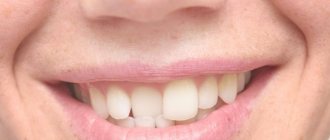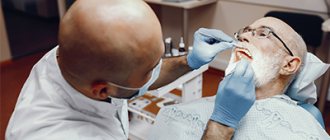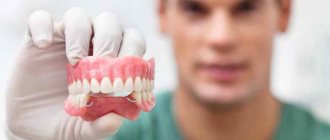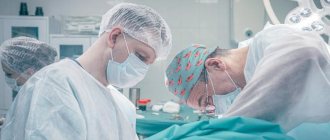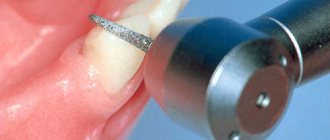- What is implantation
- Which doctor performs the procedure
- Indications and contraindications
- Features of the procedure
- Possible complications
- In conclusion
Modern dentistry now has enormous capabilities not only for treatment, but also for dental restoration. Among dental procedures, the installation of implants now occupies a leading position. Many people think about this operation, but most have questions: who does dental implantation and what are the features of the procedure. Such information is necessary in order to avoid receiving poor-quality services and possible further complications when choosing dentistry (often arise if implantation is carried out by an unqualified specialist).
What is implantation
People who have not previously encountered implantation have somewhat generalized information about this dental procedure. The installation of implants is often mistakenly mistaken for prosthetics. However, these are mini-operations, despite the similar goals, dental restoration is a completely different procedure.
Implantation is a dental operation to insert a pin or, as they are correctly called, an implant into the jaw tissue (in place of a missing tooth). In the future, the pin will replace the root, on which a structure will be installed to replace the tooth.
The operation has many features, one of which is the absence of the need for your own bone and jaw tissue. Unlike prosthetics, this method is used even in severe cases of dental pathologies.
The success of the procedure largely depends on which doctor installs the dental implants. If a specialist makes mistakes, serious complications are possible that require immediate treatment.
Rubric “Question and answer”
Who is a dentist?
The concept was used in the 20th century and is now considered obsolete. Previously, the term was used to describe dentists who did not have a special higher education. In foreign countries, a dentist is a dentist who has received secondary education in his specialty. This term can be used to describe a dental laboratory specialist, a dentist, or a paramedic.
Can a dentist perform the duties of a dentist?
The answer to the question will be negative, since the dentist does not have the necessary skills and knowledge to carry out the procedures that are the responsibility of a dental therapist.
Which doctor performs the procedure
In the majority, people believe that a dentist is a generalist doctor who alone performs absolutely any procedure in this field of medicine. This is not at all true; in dentistry there are several areas where doctors of a certain specialization work.
Of course, one doctor can have several specialties, however, for example, to perform surgical operations (including implantation) requires appropriate qualifications.
So who puts implants? Which specialist should you contact if you need a service?
The first appointment is most often carried out by a dentist in the therapeutic department to determine the indications and prescribe diagnostics. If the patient has no contraindications, and the need for implantation is confirmed, then a day of surgery is scheduled, which will be performed by a doctor with experience in installing implants and prosthetics. Which doctor performs dental implants? Popularly, such a doctor is called an implantologist; in medicine, a surgeon or orthopedist.
Survey
Diagnostics helps to accurately assess the condition of teeth, gums, and facial bones and determine the optimal method of treating edentulism. To do this, the dentist:
- Interviews the patient and listens to complaints.
- Examines all organs of the oral cavity - teeth, gums, tongue.
- Prescribes radiography or CT (computed tomography).
The images help determine whether the teeth adjacent to the defect are suitable for use as supports. Sometimes, after radiography, it also turns out that adjacent units are not suitable for adjacent implants or bridges.
Indications and contraindications
Implantation cannot be performed at the first visit, only at the request of the patient. In order to install implants, the dentist must confirm the indications for surgery.
Indications include pathologies of the dentition or jaw bones:
- missing one tooth;
- absence of 2 or more dental organs, with adjacent location;
- absence of the last teeth without the possibility of restoration by other methods;
- complete edentia (congenital pathology characterized by the absence of teeth);
- the presence of reasons preventing the wearing of a removable denture (for example, a gag reflex);
- pain caused by functional occlusion;
- absence of alveolar processes in the upper jaw with concomitant complete absence of teeth;
- anatomical defects that arise as a result of diseases, mechanical effects, as well as as a result of disturbances during intrauterine development or genetic predisposition.
In implantology, each case is necessarily considered taking into account the individual characteristics of the dental composition and jaw structure of each patient. An implant can be placed only after diagnosis. A qualified specialist will not carry out the procedure without a preliminary examination.
Contraindications
Diagnostics are necessary not only to confirm the indications, but also to determine the possible presence of contraindications to implantation.
Absolute contraindications for which implants should not be installed include diseases and pathological conditions:
- severe diseases of the cardiovascular system;
- malignant oncological diseases;
- diseases of the nervous system;
- blood pathologies (especially poor clotting);
- severe connective tissue diseases;
- open tuberculosis;
- liver/renal failure during exacerbation;
- increased tone of the masticatory muscles in combination with bruxism;
- diabetes mellitus;
- immunodeficiency diseases;
- allergic reaction to painkillers;
- addiction to drugs or alcohol.
Implantation is not carried out for women carrying a child, as well as for children under 18 years of age. Fixed dentures are not installed until the age of 22. This is due to the fact that until the age of 22, a person’s jaw continues to grow and form. Between the ages of 22 and 25, surgery is performed only for serious indications.
The benefits of progress
Living in the 21st century, we sometimes don’t realize how lucky we are. It is not even necessary to compare the current state of affairs with, for example, the Middle Ages, when the teeth of deceased people were used as prosthetics. Just look back 30-40 years. In the Soviet Union, crowns on the front teeth became an automatic “sentence” for a smile - after all, metal dentures oxidized and looked unaesthetic.
Interesting fact! During the war between the North and South, entire barrels with the teeth of dead soldiers were sent from the United States to Great Britain. They made prosthetics from them.
Nowadays, the specialist who places crowns on teeth has access to many tools and materials that allow him to install dentures that are indistinguishable from real teeth.
Features of the procedure
Implantation is performed in several stages, which the patient is recommended to inquire about in advance. Depending on the type of procedure and type of implants, the operation can be performed in one step, or it can stretch over several stages, which will take up to six months. If long-term treatment is expected, temporary structures and crowns are installed.
Types of implants
Dentistry offers several options for implants. However, they are all made of the same titanium. This material is considered the most reliable and safe. All products are divided into several types according to design and shape. Depending on the indications, the most suitable installation option is selected. In addition to indications, the choice of implant model is also influenced by their cost. Modern designs tend to be more expensive, but more convenient and durable.
By type of design:
- collapsible
- non-separable.
According to the shape of the products:
- lamellar - screwed into the bone tissue under the palate;
- root-shaped - installed in root canals;
- combined - placed in the root canal.
The clinic’s specialists are qualified and experienced in installing any type of implants. The dentist will recommend which type of implants is suitable, based on the patient’s indications and wishes.
Installation Methods
The A-Medic clinic is equipped with exclusively modern technology, which allows us to perform all types of dental implantation. Implantologists have sufficient experience to solve problems even with complex dental pathologies.
Surgical dentistry, depending on the characteristics of the jaw, offers three options for dental implantation:
- basal - an inexpensive and quick method that allows you to install implants, and even more than one, immediately after tooth extraction;
- intraosseous - a method recommended after bone grafting;
- laser - a low-traumatic operation, possible only if the bone is preserved with a height of at least 6 mm;
- subperiosteal - an implantation method used when the patient lacks bone tissue (does not require additional bone augmentation);
- transgingival - a minimally invasive technique is used to open the gum tissue to install one or more products;
- endodonto-endosseous - the pin is inserted into the canal (the gum is not cut), allowing the root to be preserved;
- intramucosal - used in the absence of intraosseous implantation, suitable for increasing the fixation rates of removable dentures;
- transosseous - recommended for atrophy of the soft and bone tissues of the lower jaw;
- Express - implantation - temporary introduction of an implant and a temporary crown.
The dental clinic performs operations for both partial restoration of dental organs and turnkey dental implantation. You can read reviews about the results of the specialists’ work on the company’s website and on third-party sites.
Diagnostic methods for an orthopedic dentist
Based on the individual characteristics of the patient’s teeth, the doctor selects appropriate research methods. A panoramic photograph of the jaw, an orthopantomogram, or an x-ray of one or more teeth may be offered. A couple of months after prosthetics, the patient will need to take a control photo to evaluate the work performed.
After conducting instrumental diagnostics, the orthopedic dentist can prescribe consultations with other specialized specialists, for example, an orthodontist. After all the data necessary for treatment has been collected, the doctor draws up a plan for further therapy for the patient. All responsibility for the correct selection and production of an individual prosthesis lies with the orthopedic surgeon.
Possible complications
Dental implants are a foreign material for the body, so the risk of complications can never be excluded. Modern product installation methods and techniques can minimize this risk as much as possible.
Possible complications:
- seam divergence;
- severe pain for more than three days;
- formation of hematomas;
- the appearance of bleeding;
- development of soft tissue inflammation.
Such complications are rather exceptions that arise due to compliance with the doctor’s advice on care during the rehabilitation period.
Somewhat more often, implant rejection and inflammation of the bone and gum tissue near the implant occur. The cause of inflammation can be insufficient oral care or violation of doctor’s recommendations. Implant rejection is an individual reaction of the body. The result is also influenced by which doctor places the dental implants. A qualified specialist will not make mistakes during the operation, and will monitor the patient’s condition throughout the entire rehabilitation in order to take timely measures and prevent complications.
Preparing for an appointment and how an appointment with an orthopedic dentist goes
It is not recommended to drink alcohol before seeing a specialist. The presence of alcohol in the patient's blood negatively affects the effect of anesthetic drugs. If the patient is sick, then you should postpone your visit for a while. Before coming to the dental office, you should thoroughly brush your teeth. Therefore, it is advisable to discuss the time of your appointment with the dentist in advance.
At the first consultation, the doctor must determine the degree of damage to the patient’s masticatory apparatus. Before starting orthopedic treatment, complex surgical and therapeutic treatment of the oral cavity is carried out. This makes it possible to carefully prepare the soft and hard tissues of the patient’s maxillofacial area for upcoming procedures. Treatment of the following diseases is mandatory:
- Pulpitis,
- Caries,
- Scar changes in the mucous membrane,
- Stomatitis, gingivitis, periodontitis.
During the appointment, the orthopedic dentist examines the patient’s oral cavity and listens to complaints. The inspection can be visual and instrumental. Next, the doctor takes impressions and photographs the dentition. If necessary, a consultation with a dental surgeon is scheduled. Based on the data obtained, the doctor draws up a further treatment plan for the patient.
In conclusion
Many people believe that installing implants is harmful to the body, since serious complications are possible. However, we should not forget that the absence of teeth also negatively affects health, since in addition to aesthetics (smile), a person’s teeth also perform a certain function (chewing food). The absence of certain teeth leads to a decrease in self-esteem, which affects a person’s psycho-emotional state, as well as problems with the gastrointestinal tract, since food is not chewed thoroughly enough.
You should not delay your visit to the doctor, assuming that implantation will cost too much or that it is not necessary. Of course, this is not a cheap service, but the result is worth the money spent.
Prosthetic options
A qualified orthopedist will take into account not only your aesthetic wishes, but also the condition of the oral cavity as a whole, as well as your physiological characteristics. For example: ceramic crowns are the most aesthetically pleasing. However, if you have a massive jaw, then they will be too fragile, and zirconium-ceramic dentures will be an alternative.
A crown for a front tooth can be made from:
- Metal ceramics: a layer of ceramics is applied to a metal base made of an alloy of chromium and cobalt (sometimes gold). Such designs have a reasonable price, they are reliable and quite aesthetic, but they also have disadvantages: healthy teeth are seriously affected; A blue stripe appears along the gingival margin. Contraindicated for those who suffer from metal allergies.
- Ceramics: excellent aesthetic indicators, but only single prosthetics are acceptable. Quite fragile.
- Zirconia: the hypoallergenic material is not inferior to metal in strength, and is significantly superior to it in aesthetics. One of the disadvantages is that the artificial tooth lacks “transparency”.
- Ceramics on a zirconium frame: a combination of maximum reliability and excellent aesthetics.
The stages of installing a crown on a tooth remain the same, regardless of which tooth we are talking about. Only the materials are important, because a fragile crown cannot be placed on a chewing tooth, and a less aesthetic one cannot be placed on a front tooth.

